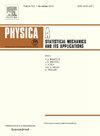Exploring the core–periphery and community structure in the financial networks through random matrix theory
IF 2.8
3区 物理与天体物理
Q2 PHYSICS, MULTIDISCIPLINARY
Physica A: Statistical Mechanics and its Applications
Pub Date : 2025-01-30
DOI:10.1016/j.physa.2025.130403
引用次数: 0
Abstract
In finance, Random Matrix Theory (RMT) is an important tool for filtering out noise from large datasets, revealing true correlations among stocks, and enhancing risk management and portfolio optimization. Therefore, we employ RMT to filter out noise from the full cross-correlation matrix of stock price returns for the NIFTY 200 and NIFTY 500 indices on the National Stock Exchange of India. Next, we apply the network theory tools to analyze market and sector modes as filtered correlation structures to study local interactions within financial networks. This allows us to study the very fundamental properties of networks, such as the core–periphery and the community structure of constructed networks over these filtered modes, and compare the results with the network constructed over the full cross-correlation matrix. The results suggest that the core–periphery structure is contained in the market mode, while the community structure is in the sector mode. Thus, both modes outperform the full cross-correlation in terms of capturing the essential respective structure of the network. Furthermore, we used these insights to build portfolios based on communities of the networks corresponding to the sector mode and the network corresponding to the full cross-correlation matrix. The results suggest that the portfolio constructed on the full cross-correlation-based matrix performs better than the sector mode. These insights provide a greater understanding of RMT application in the financial market.
求助全文
约1分钟内获得全文
求助全文
来源期刊
CiteScore
7.20
自引率
9.10%
发文量
852
审稿时长
6.6 months
期刊介绍:
Physica A: Statistical Mechanics and its Applications
Recognized by the European Physical Society
Physica A publishes research in the field of statistical mechanics and its applications.
Statistical mechanics sets out to explain the behaviour of macroscopic systems by studying the statistical properties of their microscopic constituents.
Applications of the techniques of statistical mechanics are widespread, and include: applications to physical systems such as solids, liquids and gases; applications to chemical and biological systems (colloids, interfaces, complex fluids, polymers and biopolymers, cell physics); and other interdisciplinary applications to for instance biological, economical and sociological systems.

 求助内容:
求助内容: 应助结果提醒方式:
应助结果提醒方式:


